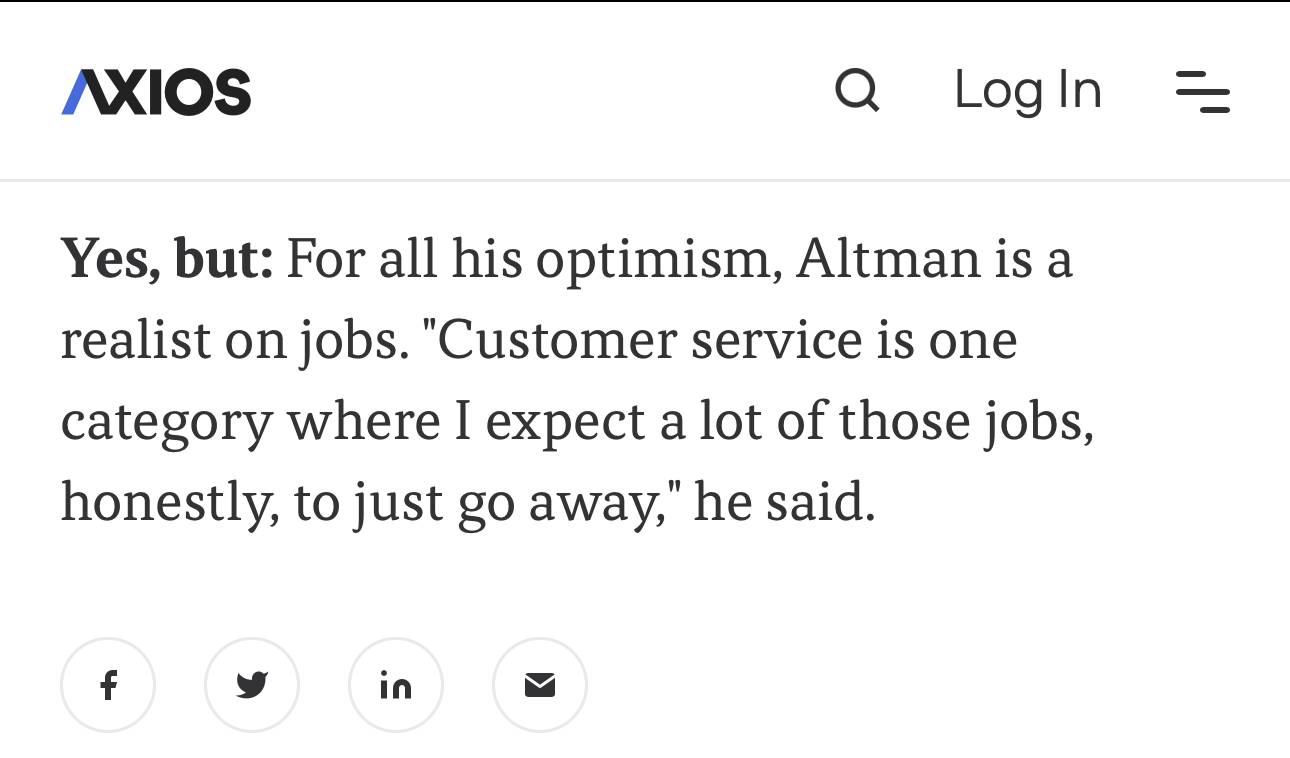A Company’s Single Store of Knowledge
The best thing a product marketing team can do for a sales team is give them ONE PLACE TO LOOK & SEARCH for the things they need. When you have a single source of truth, things become so much easier, and it’s easier to fill in the gaps.
Bonus thought: Ideally, each page would have a comment section so you can gauge the vailidity and helpfulness of each document. This is why good wiki software is such a good solution, but it has to be adopted across the WHOLE team.
I’ve led a few crosss-company projects to consolidate knowledge into one wiki, and its not easy; but the reward is there if you stick with it.
On buying software:
I’ve been on so many calls with robot SDR’s who probably mean well but their incentives don’t allow them to have human conversations.
It’s Beep. BANT. Boop. MEDDPICC.
Sales leaders need to do better for their teams.
Copywriting and StoryTelling
I found my love of copywriting and storytelling way back when I worked in an eBay store making $6.50 per hour. It’s my view that if you can write great copy and tell a great story, you can change the world.
In that eBay store, I would help to sell things on other’s behalf. It was my job to maximize the value of the product. Rather than just pasting product descriptions and generic specs, I learned that I had to write compelling headlines & hooks, and lead people toward a click. I had to learn what drew the people to the products in the first place. I had to weave that story into the product description.
Copy is at the very heart of every eBay listing, sales pitch, great investor deck, and every story. There are people who can write copy, but cannot tell a story. I have been told that one of my greatest strengths as the ability to combine those skills and create a narrative that helps companies grow. This growth does not come in a vacuum inside the marketing department. Great narratives combine great copywriting and great storytelling, but can be told by anyone in the organization.
Across every department, from the most strategic account executive, to the bookkeeper, to the summer intern; everyone needs to be able to use the same words to describe what the company is trying to do.
This is critical for a variety of reasons. One, if we expect our customers to understand what we do, we need to be very clear about giving them the words to use. I believe the product marketing job is to give customers the words to use in order to refer people that they know in our direction. If that is the north star, it guides everything we do.
Simplicity in message, simplicity in outcomes we deliver, simplicity on creating product launches that connect to the company vision.
These are all outcomes from creating a compelling company narrative based on copy writing and storytelling.
Too many companies launch features with a big splashy day, but they fail to follow up and use their product innovation to drive expansion in new customers.
This is typically because many features are launched and are never followed up on again. That’s a customer marketing problem.
Another reason this happens is that sales reps are not given the story that connects that new feature or product back to the company story.
I love helping people tell company stories. I love helping to create, package, and launch products the connect back to that company story. I believe that every feature that the company builds should be able to be tied back to that company’s vision through the company story. This makes it easier for customers to understand what we are building, but also makes it easier for sales reps to communicate the value of any new feature launch.
(I recently posted about this in a post called “The Product Marketing Ladder”, and am expanding on the process in future posts.)
To fail to give reps this connective issue is marketing malpractice.
How to Craft Better ChatGPT Prompts
I was asked a question on LinkedIn about how to craft better prompts for ChatGPT.
There are A LOT of thread people on Twitter sharing nonsense tips. It’s hard to find the signal in the noise. But… I have learned a few things that have helped me.
Most people ask it a question, ask it to produce an answer, or ask it to compose content. That’s fine. But they miss the most important thing, The System.
What is the “System”?
The System is the part of the prompt that tells the robot what it is, what it’s goals are, how to think about its response, and how to phrase it.
It’s one part of the puzzle that becomes clear when you log into the OpenAI Playground.
The other part of a prompt is “The Message”. That’s what most people type right in and expect greatness. Most of the prompts people share are just the message part.
Without the setup of the “System”, a “Message” doesn’t provide the background or guardrails needed to influence the voice and tone, or areas of known knowledge to pull from. The system is also great place to provide specifics around the format of the type answers that you want.
Check out this library for some inspiration on system prompts to pair with your “message” requests and it’ll immediately level up your game. I’ll try to post more about this soon and include some examples.
🪜 The Product Marketing Ladder
Feature ⬇️ Product ⬇️ Platform ⬇️ Market ⬇️ Category ⬇️ Mission ⬇️ Vision
Everything has to ladder back down to the vision. If it doesn’t. Maybe you shouldn’t have built it?
The Least Bad Path
The hardest (well, one of them anyway) part about product marketing is choosing how to spend your time to make the most impact.
Everyone wants a little piece of your work, and you ultimately have to find a path that’s the least bad in serving them.
And sometimes, not giving them what they want is what you need to do for the business.
A practical example:
You get a slack message:
AE: “hey there how are you how’s it going can you help me make some small tweaks for a deck I need for an opportunity that’s about to close?”
PMM: “hey, I’d love to be able to point you in the right direction. When do you need it?”
AE: “2pm”
PMM: …checks watch, looks at calendar…
🧐 What do you do?
In my experience, this is symptomatic of two solvable problems.
-
You haven’t given the reps a framework for what PMM does, how to make requests, and how to work with YOU.
-
You haven’t made it clear to the reps how everything matters up to the company vision , strategy, category, and story.
-
(Bonus thing) you probably haven’t made it easy for people to assemble assets based on an approved framework. And the reps likely aren’t fully onboarded on how to tell the story well enough.
Agree or disagree? Have you found yourself in this situation? What have you done about it? I have some ideas and experience here. But am more curious what others have done.
#productmarketing #salesenablement #narrativedesign

How things work around here
Something I’ve learned over time (and it’s something i should have learned much earlier).
“How things work around here” should be very evident in the values and leadership principles set out by the company.
Anyone ought to be able to understand how decisions are made by looking at these kinds of guardrails before they join a company.
If they aren’t in place, it means the company will struggle to move fast.
If you are in product marketing at a company that has apps, you are going to want to check this out. If you aren’t, you still are. Apple is likely to set the standard for in-the-moment customer education.
Read more: Make features discoverable with TipKit - WWDC23 - Videos - Apple Developer ➚
Apple mentioned that the Vision Pro is their first 3D camera. Stands to reason that a yet to be released iPhone Pro will be the second 3D camera.
Just saw an ad for a “Product Led Email” platform.
The whole X-Led-Y messaging has completely lost its meaning at this point.
While I still believe in making the principles of product-led growth a core part of business today, the name for it needs to change.
my LinkedIn strategy
On what i share on LinkedIn: I used to be all in with just sharing updates about the company I worked for and found that I lost my audience entirely.
My strategy has now been to share company updates (minus Tier 1 launches) as examples of the product marketing or GTM strategy when I share professionally, but that the topic should be helpful to people in my field. Which helps with relationships, recruiting, and more.
Talking about a launch I am working on is only useful to my audience in the context of how to run a launch vs. me building an audience of people who want that product.
In my view, the Product Marketing function is there to help the people in the company use the best words. Not necessarily to be the one everyone looks to on social media for those words.
While others zig, there’s a way for some customer-centric companies to zag and not seek to “replace” customer service, but augment it.
Sam Altman: OpenAI plans a pro-copyright model for ChatGPT

Two ears. One mouth.
Two ears. One mouth. I led a Product Positioning workshop this morning with a startup I advise. When you are on a virtual meeting whether it’s sales call, or doing internal brainstorming, or a positioning workshop with startup founders….
… act as a conversation facilitator (not a lecturer).
That means fighting the urge to talk, and taking a beat whenever it feels like it’s your turn because most of the time, the other party has more to say. If not, it’s important ot prompt for more when necessary.
- “Tell me more about THAT.”
- “Why do you think that is?”
- “Can you say that in a different way?”
What are some facilitation question you use to uncover insights in your virtual meetings?
#productmarketing #remotegtm #sales

The marketing team when the third CMO in a year rolls in.

Innovative product marketing is about putting words into your potential customers mouths. Discover this, a whole new world of opportunity opens up. Train prospects to yearn for the outcome you deliver, and make sure your product just happens to solve for that outcome.
Closing the sale NOT THE FINISH LINE. If you offer true value to your customers, you know this to be true. You know that ClosedWon is when the real work begins.
“Finally, you can replace this thing that you despise” is a powerful marketing message. “Finally, you can replace this thing that you love” is not.
via @gruber Source: artifact.news/s/UtcaEKP…
let me ai that for you.
We have all worked with people who don’t know how to use Google for basic things, am I right? In fact, being great at Google has been a superpower for many folks in the workforce today. Remembering this is the key to the next unlock…
In short order, the people who don’t know how to use basic AI (in whatever form that takes) will be the new “why don’t they just Google that?” people.
It’s in one’s best interest to stay 🆙 on all of it. The peak performers will be. You can count on that.
free ebook
Most marketing I see is mindnumbingly boring and completely devoid of soul. What do you STAND for?
I get it. It’s easier to just go with the flow and not ruffle any feathers.
But no one ever built a lasting business tricking people into filling out forms with a shitty ebook no one actually wrote (outsourced the thinking to interns or DuJourGPT) and no one is expected to read (emailing a link to a pdf).
Make the audience stop and think. The marketing or content doesn’t have to be a great novel, but it should actually provoke some thought.
